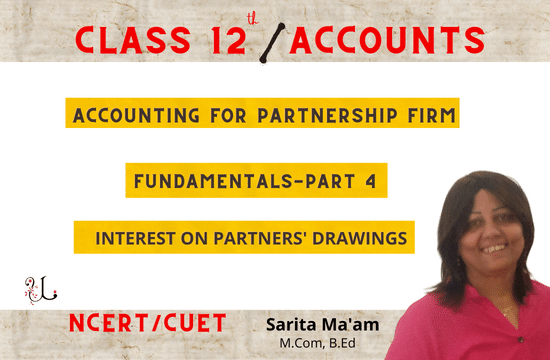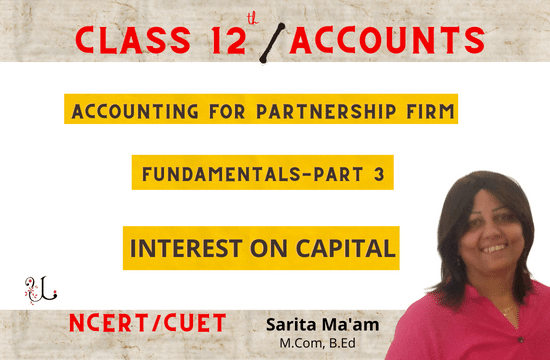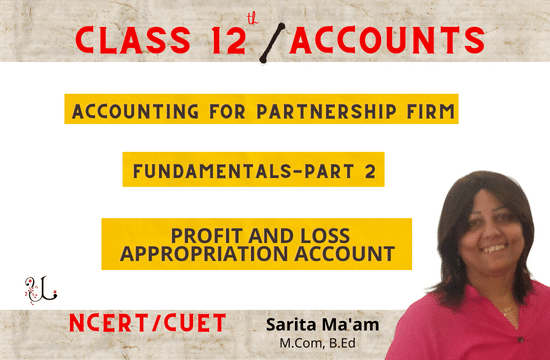Partnership:
Partnership is an association of two or more persons (should not be more than 50) who have agreed to share profits of a business carried on by them.
Features of Partnership
- Association of two or more persons
- Does not have a separate legal entity
- Unlimited liability of the partners
- Agreement may be oral or written
Partnership is defined by Indian Partnership Act, 1932, Section 4, as follows:
Partnership is the relation between persons who have agreed to share the profits of a business carried on by all or any of them acting for all.”
The persons who have entered into a partnership with one another individually are called partners and collectively a firm. The name under which the business is carried is called firm name.
Nature of Partnership
Partnership, from the legal viewpoint, is not a separate legal entity from its partners. It means, firm’s debts can be paid from private assets of the partners, if the firm is not able to pay its liabilities.
Problem
A partnership firm is dissolved with the consent of all partners. On the day of dissolution, firm’s liabilities were ₹12,00,000 and assets were ₹10,00,000. The firm is not in the position to pay off the excess of liabilities (₹2,00,000) over its assets. One of the partner, Nikunj has private property worth ₹3,00,000 and his private debt amounted to ₹1,00,000. Can the surplus of the private assets over private debt (₹2,00,000) be used to pay off the firm’s unpaid liabilities. Briefly explain the concept behind this.
Sol
Yes, Under partnership Act Sec. 49, out of ₹3,00,000 first he would pay off his private debt of ₹1,00,000. After paying ₹1,00,000 surplus money of ₹ 2,00,000 he would pay firm’s unpaid liability.
Partnership is a separate business entity from the accounting viewpoint
Rights of Partners
- Right to participate in the management of the business.
- Right to be consulted about the affairs of the business.
- Right to inspect the books of account and have a copy of it.
- Right to share profits or losses with others in the agreed ratio.
- Right not to allow the admission of a new partner.
Essential Features or Characteristics of Partnership
- Two or More Persons: There must be at least two persons to form a partnership and all such persons must be competent to contract. According to Indian Contract Act, 1872, every person except the following are competent to contract:
- Minor,
- Persons of unsound mind, and
- Persons disqualified by any law.
Maximum Number of Partners: The Companies Act, 2013 The Central Government has prescribed maximum number of partners in a firm to be 50 vide Rule 10 of the Companies (Miscellaneous) Rules, 2014. Thus, in effect, a partnership firm cannot have more than 50 partners
- Lawful Business: A partnership is established for a lawful business.
- Profit-sharing: The agreement between/among the partners must be to share profits and losses of the business. It is not essential that all the partners must share losses
It is compulsory to share profits but not compulsory to share losses.
- Business can be carried on by All or Any of the Partners Acting for All: Business of the partnership can be carried on by all the partners or by any of them acting for all the partners.
In other words, partners are agents as well as the principals.
As an agent, he represents other partners and thereby, binds them through his acts. As a principal, he is bound by the act of other partners.
- Agreement: Partnership comes into existence by an agreement, either written or oral. It is the basis of relationship among partners, which may be for a particular venture, for a period or at will. The written agreement among the partners is known as Partnership Deed.
Partnership Deed :
It is an agreement between two or more than two partners for determining their mutual contract relationship and its limitation for better and effective operation of business.
The partnership Deed should contain the following Points
- Profit Sharing Ratio*
- Interest on Capital*
- Interest on Drawings*
- Remuneration to Partners (Salary, Bonus, Commission)*
- Interest on Advance/Loan by a Partner*
- Valuation of Assets
- Valuation of Goodwill
- Right and Duties of Partners
- Capital Contribution
- Settlement of Disputes
Rules Applicable in the Absence of Partnership Deed
Provisions of the Indian Partnership Act, 1932 in the absence of Partnership Deed
It is not essential but desirable to have a Partnership Deed. In case Partnership Deed does exist, provisions of the Indian Partnership, Act, 1932 will apply
- Interest on Partner’s/s’ Loan — 6% p.a.
- Interest on Capital — No interest to be paid
- Interest on Drawing — No interest to be charged
- Salary or Commission to Partners — No salary or commission to be paid
- Profit Sharing Ratio — Profits to be distributed equally
Some other Important Provisions of the Indian Partnership Act, 1932
(i) If all the partners agree, a minor may be admitted for the benefit of the partnership.
[Sec. 30]
(ii) A person may be admitted as a partner either with the consent of all the existing partners or in accordance with an agreement among the partners. [Sec. 31]
(iii) A partner may retire from the firm either with the consent of all the other partners or in accordance with an agreement among the partners. [Sec. 32]
How will be the matter resolved?
Nikunj and Nitin are partners in a firm without a Partnership Deed
(i) Nitin wants to introduce his daughter Rolly as a partner. Nikunj objects to his proposal
Sol
Partner cannot be admitted without the consent of both the partners
NOTE : partners do not have a Partnership Deed. Therefore, provisions of the Indian Partnership Act, 1932 will apply to resolve the matters
(ii) Nikunj, has contributed more capital than Nitin and demands interest on capital at 10% p.a. But Nitin do not agree with him
Sol
Interest on capital is not payable to partner. Therefore, Nikunj will not get interest on the capital.
NOTE : partners do not have a Partnership Deed. Therefore, provisions of the Indian Partnership Act, 1932 will apply to resolve the matters
(iii) Nikunj has withdrawn ₹ 10,000 from the firm for his personal use. Nitin demands that interest on drawings should be charged @ 10% p. a.
Sol
Interest on Nikunj’s Drawings will not be charged
NOTE : partners do not have a Partnership Deed. Therefore, provisions of the Indian Partnership Act, 1932 will apply to resolve the matters
(iv) Nikunj devotes full time in the business and demands a salary of 5,000 p.m. But Nitin do not agree with him
Sol
Remuneration is not payable to partner. Therefore, Nikunj will not get salary
NOTE : partners do not have a Partnership Deed. Therefore, provisions of the Indian Partnership Act, 1932 will apply to resolve the matters
(v)Nitin demands interest on the loan of ₹ 1,00,000 given by him at the market rate of interest, i.e., @ 12% p.a.
Sol
Interest on Loan by Partner is payable @ 6% p.a. Therefore, Nitin will get interest
₹6,000 (i.e., 1,00,000 x 6/100).
NOTE : partners do not have a Partnership Deed. Therefore, provisions of the Indian Partnership Act, 1932 will apply to resolve the matters
(vi) Profit before taking into account any of the above claims was ₹1,56,000 at the end of the first year of the business. Nikunj demands share of profit in the capital ratio.
Sol
Profit after Interest on Loan by Nitin, i.e., (₹1,56,000 -₹6,000) ₹1,50,000 is to be distributed equally. i.e. ₹75,000 to each partner.
NOTE : partners do not have a Partnership Deed. Therefore, provisions of the Indian Partnership Act, 1932 will apply to resolve the matters
Test Your Knowledge:
Q1. As per the Partnership Act, 1932 what is the maximum limit regarding the number of partners in a partnership business?
(a) 20 (b) 50 (c) 100 (d) None of These
ANS
- (B) 50
Note: Maximum limit of partners is fixed by the Companies Act and not by Partnership Act.
Q2. Partners collectively are called:
(a) Company (b) Registered Business (c) Firm (d) Firm’s name
ANS
- (C) Firm
Q3. X, Y and Z are partners sharing profits and losses equally. Their capital balances on March, 31, 2012 are ₹80,000, ₹60,000 and ₹40,000 respectively. Their personal assets are worth as follows : X — ₹20,000, Y — ₹15,000 and Z — ₹10,000. The extent of their liability in the firm would be :
(A) X — ₹80,000 : Y — ₹60,000 : and Z — ₹40,000
(B) X — ₹20,000 : Y — ₹15,000 : and Z — ₹10,000
(C) X — ₹1,00,000 : Y — ₹75,000 : and Z — ₹50,000
(D) Equal
ANS
(B) X — ₹20,000 : Y — ₹15,000 : and Z — ₹10,000
Q4. Liability of Partners is :
(a) Limited (b) Unlimited
(c) Determined by partnerships Account (d) None of these
ANS
(b) Unlimited

Sarita Chugh M.Com, B.Edan is Accounts and Economics teacher having more than 30+ years of experience. She is Edupreneur and founded Unique Learning Academy in 2004. She believes that every child has the right to affordable education.






